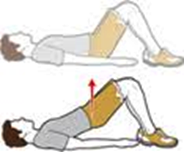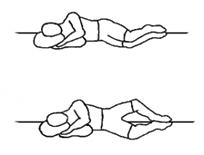These are three simple, yet effective, core and hip stability exercises for runners that help to decrease the risk of low back, hip or knee pain and can also help to increase running efficiency.
- Glute bridge
This exercise is designed to target your glutes. Weakness in a runner’s glutes often leads to low back pain and tightness and/or strains in the hamstrings.
- Start by laying on your back with your knees bent and your feet flat on the floor
- Drive your hips into the air by squeezing your glutes (your bum muscles)
- Hold this position at the top for 2 seconds and return back to the ground
- Repeat for a total of 12 repetitions
** If you are feeling this exercise in your low back you are either not squeezing your glutes enough to lift your hips or you are lifting your hips too high off the ground. The idea with this exercise is to feel it predominantly in your glutes with some in your hamstrings and nothing in your low back.
- Clams
This exercise is designed to target the glute muscles at the sides of your hips. These muscles are responsible for holding your hips steady as you run so you do not create a lot of side to side motion. Strengthening these muscles can help with low back pain or knee pain (especially pain on the outside of your knee).
- Start by laying on your side with your knees and bent and your feet stacked on top of each other
- Lift your top knee while keeping your feet together
- Repeat for a total of 10 repetitions each leg
** Don’t worry about how high you lift your knee. Focus on making sure that your hips don’t roll backwards as you lift your knee. You should feel the exercise on the side of your hip.
- Bird dog
This exercise targets the core muscles. The core muscles provide stability and a solid foundation to help decrease the risk of injury and improve running efficiency.
- Start on your hands and knees with your hands lined up under your shoulders and your knees lined up under your hips
- Make sure that your back is not too rounded or too arched
- Begin by extending one arm out in front of you and bringing it back. Repeat 10 times with each arm.
- Then you can progress to extending one leg behind you and bringing it back. Repeat 10 times with each leg.
- The most challenging progression to this exercise is extending your opposite arm and leg at the same time (as seen in the picture).
** The key to this exercise is making sure that your hips don’t tilt as your limbs are moving. Picture a bowl of water placed on your low back and you do not want that water to spill!



